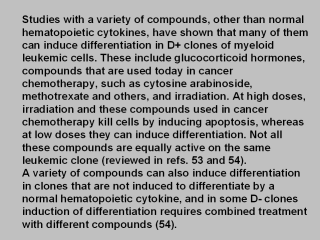 |
In addition to certain steroids,
chemotherapeutic compounds, and radiation, other compounds that can induce
differentiation in myeloid leukemic cells include insulin, bacterial
lipopolysaccharide, certain plant lectins, tumor promoting phorbol esters (reviewed
in refs. 53 and 54), and retinoic acid (reviewed in ref. 75). This effect of
retinoic acid on differentiation of promyelocytic leukemia cells is now used
clinically in the therapy of these leukemias (75), showing the successful
application of the concept of differentiation therapy in the clinic. It is
possible that all myeloid leukemic cells that are no longer susceptible to
the normal hematopoietic cytokines by themselves can be induced to
differentiate by the appropriate combination of compounds. The experiments
with myeloid leukemic cells have shown that there are different pathways of
gene expression for inducing differentiation, and that genetic changes which
suppress induction of differentiation by one compound need not affect
differentiation by another compound by alternative pathways (refs. 76 and
77; reviewed in refs. 25 and 54). These results show that there is
considerable flexibility in the myeloid differentiation program, and this
presumably also applies to other cell types.
|
